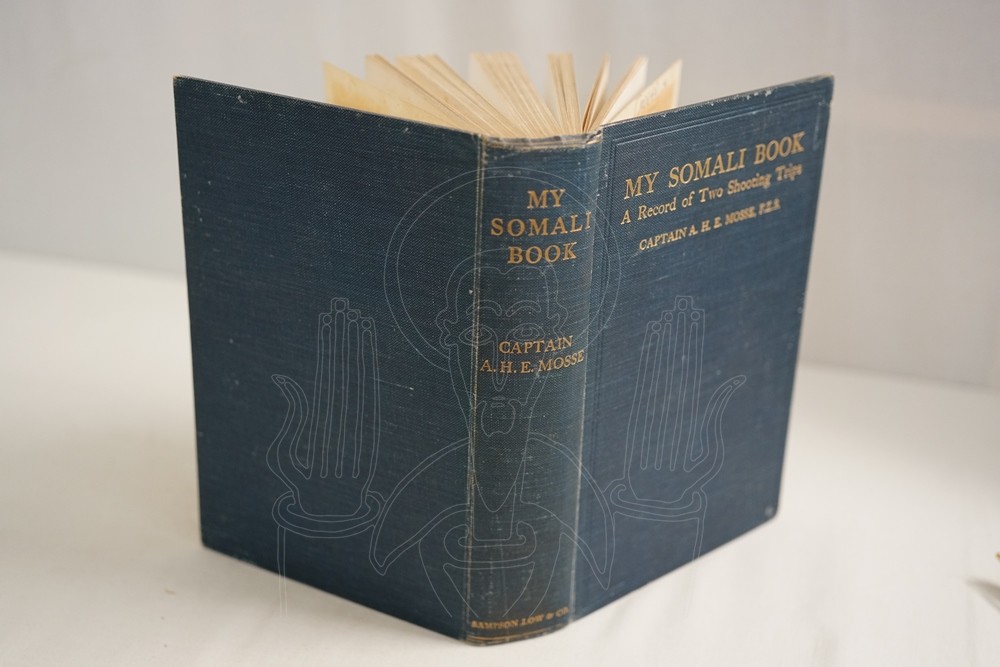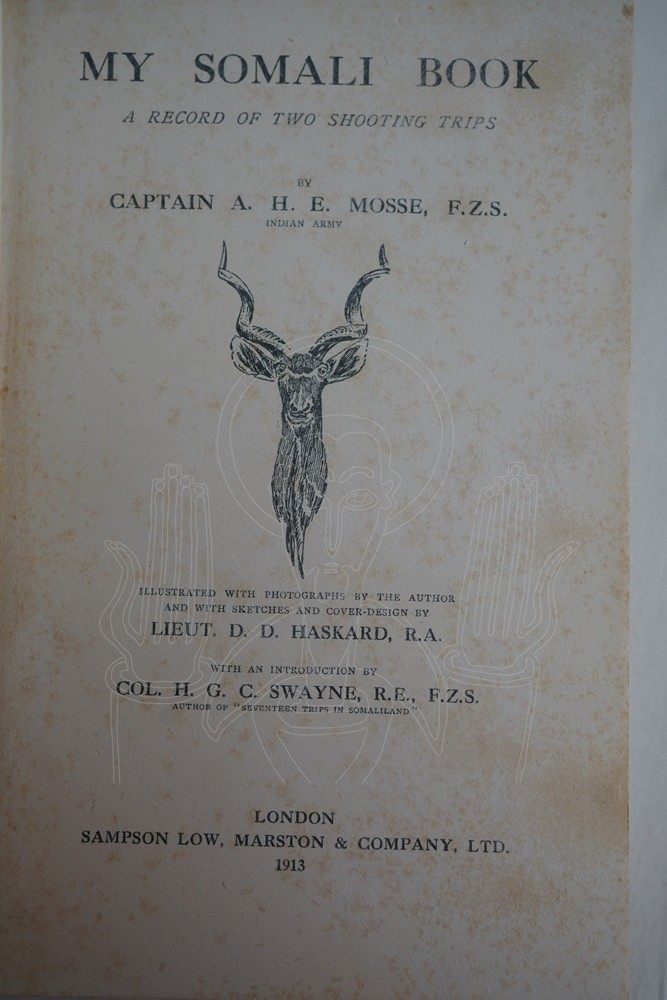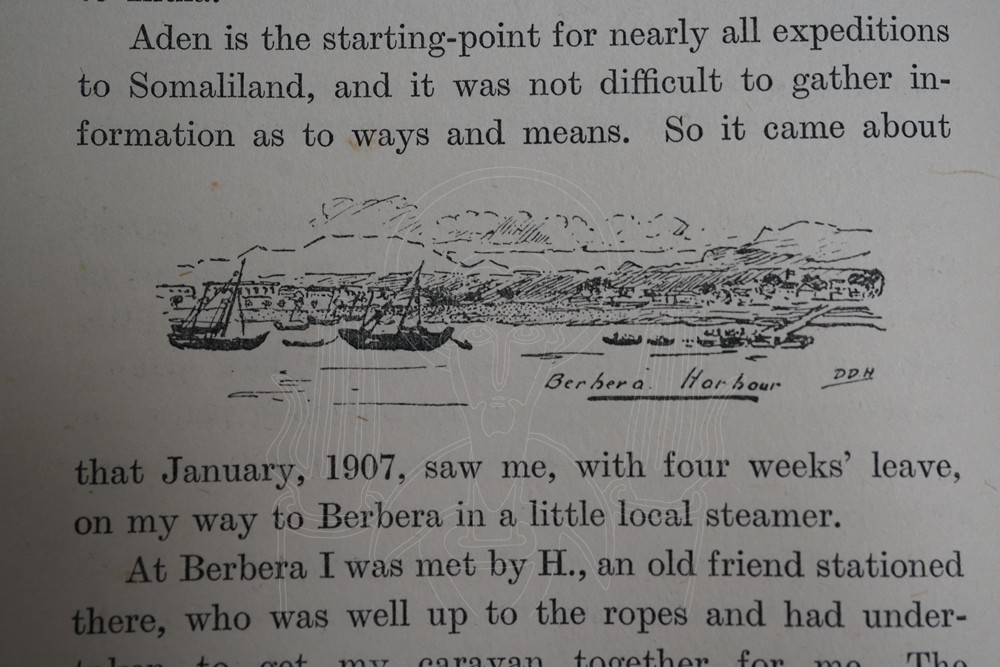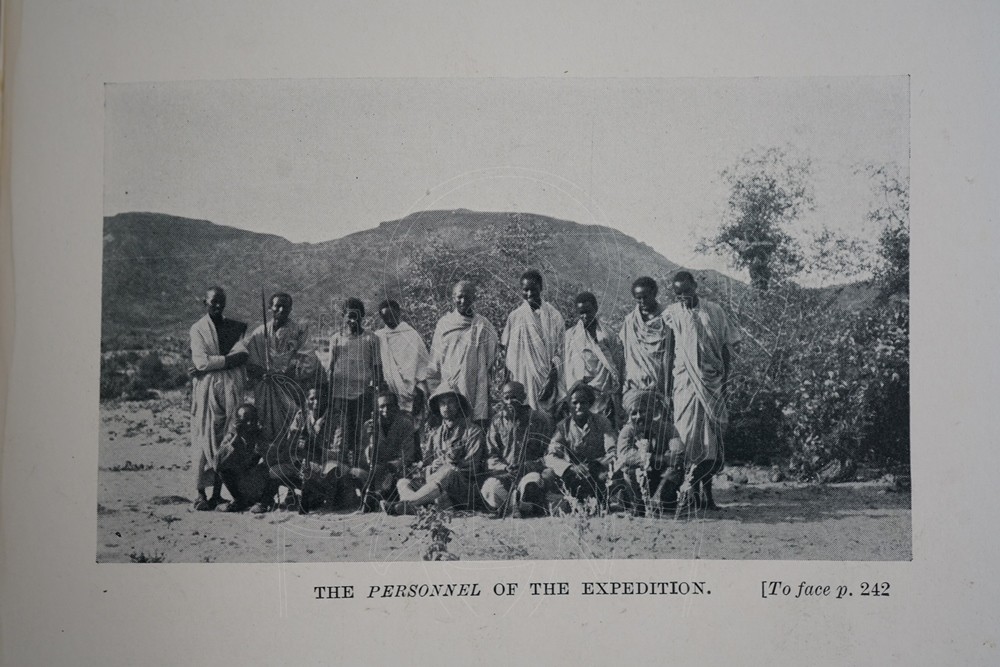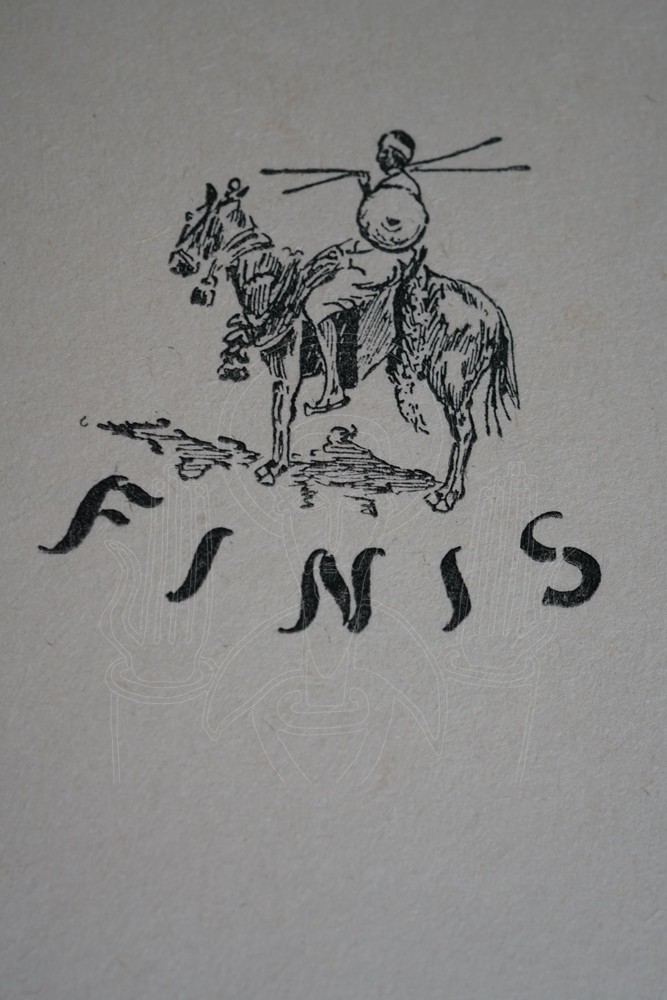Informations complémentaires
| Auteur | |
|---|---|
| Titre | |
| Éditeur | |
| Lieu d'édition | |
| Année d'édition | |
| Description | |
| Langue | |
| Reliure | |
| Signature | |
| Réf. Biblethiophile | |
| Réf. Pankhurst Partie | |
| Réf. Pankhurst Page | |
| Première entrée | |
| Sortie définitive |
| Auteur | |
|---|---|
| Titre | |
| Éditeur | |
| Lieu d'édition | |
| Année d'édition | |
| Description | |
| Langue | |
| Reliure | |
| Signature | |
| Réf. Biblethiophile | |
| Réf. Pankhurst Partie | |
| Réf. Pankhurst Page | |
| Première entrée | |
| Sortie définitive |
Illustrated with photographs by the author and with sketches and cover-design by Lieut. D.D. Haskard, R.A.. With an introduction by Col. H.G.C. Swayne, R.E., F.Z.S.
From Preface ...
OF the making of books upon big game shooting, of late years, there may seem to be no end. For the production of another some apology may appear necessary. But I have no intention of apologising. This book was written in the first instance for my own amusement, during a period when I found myself stationed in an out-of-the-way corner of India, where of other white men there were none. If an excuse be needed for its publication, it may perhaps be found in the fact that whereas there have been many recent works upon sport in other parts of Africa, Somaliland has for a number of years been left out in the cold. Moreover, ,judging by myself, I believe that a new work of this kind, provided it be true, will always be of interest to the brotherhood of big game hunters—no small class at the present day. That this book of mine will make any appeal to a wider public is more than I can venture to expect ; though to some few, especially if they be lovers of Nature, I hope that it may. To this end the pen-and-ink sketches with which it is illustrated should be of material assistance, for I am. confident I shall not be alone in thinking them attractive ; and I cannot be sufficiently grateful to their creator, my friend Mr. Haskard, for the pains he has bestowed upon them. Their truth and their artistic qualities speak for themselves.
I consider myself fortunate, also, in being honoured with an Introduction from the pen of Colonel H. G. C. Swayne, R.E., one of the first and greatest of the Somali explorers, whose name will be familiar to many of my readers as an authority both upon the country of which I write, and upon big game shooting generally. To him, for his kind interest in this work of mine, are due my most grateful thanks.A. H. E. M.
London
From Introduction ...
IT is to be feared that the country, which has been the scene of Captain Mosse’s experiences, will be closed for years to come. This is to be regretted not only by the shikari, but also by those, and they are many, who have really made friends with this cheery, kindly, intelligent, and least fanatical of Mahomedan races. It is to be regretted most by the few who knew the country in the earlier days, before it had begun to make history. In 1884, it was an unknown wilderness nominally held by Egypt, with the little Mahomedan State of Harar in the south-west corner, presenting a bulwark towards Abyssinia.
Captain Mosse is a true sportsman. Like most Anglo-Indian and African Shikaris of the keenest stamp, he shoots on foot, spares no pains, and accounts that species most valuable which gives most trouble ; he takes an interest in the ways of the people, the large game, and the birds, and gives us the result of much original observation. He gives us, too, most valuable information from the sportsman’s point of view, as to the capabilities of the various types of modern weapons.
Through Captain Mosse’s arguments on rifles runs a general tendency to uphold, up to a certain point, powerful rifles and moderately large calibres, wherein I absolutely agree with him ; though I would go still further than he does. One often travels thousands of miles by stream, hundreds of miles with pack transport, to get a shot at a particular species. One arrives at last, tired, carrying one’s loaded rifle, at a point where one may, and sooner or later will, if one perseveres, see an animal for about three seconds. Here, to have carried a little extra weight is beside the point, so long as by careful perseverance one has got there. Then, in the name of all that is sensible, have the heaviest, most powerful, most efficient, weapon you can bring to the spot, provided you can carry it yourself and handle it with ease and quickness at the important moment. Its weight will help you to two trump cards in the game, stopping power and range combined ; it will give you a third trump card, that is, all the safety that an adequate weapon can provide ; without this you may have exciting adventures, but you will not shoot long, as some animal will, sooner or later, get you, if you persist in using very light rifles.Somaliland has been an ideal hunting ground. It is one great wilderness, practically without cultivation or villages, here nearly a thorny desert, there rising to the grandest plateau, anything up to 7000 feet, with woodland scenery of beauty perhaps unsurpassed elsewhere ; you can go on horse-back, camel-back, or on foot, practically in any direction you like, if you carry a few days’ supply of water. The people have an intense love of sport, not merely for meat, and in this they differ from most African races. They are naturally hospitable to strangers. The game is difficult to bring to bag, which is a recommendation to the true sportsman ; and one is not bothered by mobs of half-tame zebras or hartebeests ranging across the front, when one is after rarer game, as they do in East Africa further south. I think that many men, whose wanderings with the rifle have been world-wide, will look back to their association with these plucky, sociable, and intelligent Somali hunters and camel-men, as among their pleasantest memories.
It is sad to think that political exigencies have now practically closed these regions ; and the sportsman, at least, will welcome any complications in the future which will again open up the country, and give him back his lost hunting grounds.H. G. C. SWAYNE
Contents ...
INTRODUCTION
Chapter I Somaliland—First trip from Aden—Berbera : preliminary arrangements—General description of Somaliland—Physical features, etc.—Inhabitants—Fauna.
Chapter II Start from Berbera—First meeting with aoul : description—Deragodleh and Lafarug—Mandéra : lesser kudu : dik-dik—Birds : the millionaire myna : king-crow—The Somali leopard : sitting up for him : bad luck—Black-backed jackal—Greater kudu : a fine trophy—A leopard’s ” kill ” : no luck again—Carrion birds : crow and mongoose.
Chapter III Across the Golis Range—Adadleh—Chita—Speke’s gazelle—Bull oryx wounded and lost—Description of oryx beisa—A jungle interlude—”Bounders ” among beasts—The spotted hyena : his character and habits—Description of gerenz’tk—Tuya Plain—” Somajesti “.
Chapter IV The Haud—Otocyon—Midgân hunters—How to attract lions—My first dibatag—On the tracks of the King of Beasts : first sight of him—Blank days—Another long day after a lion : again but a glimpse—The Somali’s bump of locality—Lose a donkey in an unusual way —Description of dibatag—Bad shooting—My first oryx—Northward again—Why I had no luck with lions.
Chapter V Tuyo again—Secretary birds—Shooting aoul on the Plain : a grand gallop—Erratic shooting : the explanation—Two good heads—The Khansa bush : a leopard’s ” kill “—Bag a small leopard—Leopard and hyenas—A long day : the elusive lesser kudu—The Jerato Pass : alakut : an unintentional crime–Mandéra again : meet H.—Shoot a lesser kudu at last—A good gerenıck—Pelzeln’s gazelle—Back in Berbera–The end of the trip.
Chapter VI Plans for a second trip—Things go wrong—M.’s success—My new battery—An aggravating delay—Start again—Berbera once more—Difficulties—Abdilleh Ashur—The rest of my following—The kharif —Start for Hargeisa—In the Reserve : partridges : sand-grouse—Weaver-birds : how to keep a husband out of mischief—Hitting a friend when he is down—Pork in sanctuary—Hargeisa : its inhabitants—The Emperor Menelek : ” sacrament rations “—An irrelevant yarn : Colonial Office exports—The A. P. O.’s poultry—An ill return for my host’s hospitality.
Chapter VII After Hargeisa—The roller and his colouring—Shooting lesser bustard with a rifle—A good dhero—Striped hywna—The second of August : Cressd dies notïı : a troop of lions : two lionesses shot—After the lions again : bag three more—Good tracking—Success of the Paradox. .
Chapter VIII Shooting on the march—Gerendk—Parturiunt montes—Bad water—My ” milk-man “—Halal—The hyæna’s laugh—Additions to the bag—Greater bustard—Aoul fawn—Kotunwein—Shooting aoul: the effect of high wind—Night-watching : a bad let-off—Consolation in store—The reward of good tracking : death of a grand black-maned lion—Lions jumping into zaribas.
Chapter IX The Sahib a universal healer—Milch-camels lost—Baby gerenzik—Tameness of antelope in the dusk—Leopard’s ” kill ” up a tree—Why it came there : the tale writ in the sandy soil : leopard and warciba—Horace in the wilds : sentiment and a criminal—A fractious camel—A Somali zariba—Sitting up for a leopard : scored off !—Water and mud—A move southward.
Chapter X The Haud again—Difficulty of shooting dibatag—Mysterious circles—Butterflies : the ” Painted Lady “—Birds at Libah Ale : nightjar : grey shrike : hoopoe—How the hoopoe gained his crest A wily jackal—A good dibatag—Chitas : no luck—North again—A leopard’s escape—The bateleur eagle—Gerenick : two bad shots and a good one—Back at Kotunwein—An exasperating incident : somajesti the aard-wolf—Somali animal nomenclature—Bustard and secretary bird—Characteristics of the aard-wolf—Kharindi killed by lion—Tuyo Plain : an exceptional aoul head—A stormy sunset.
Chapter XI A westward move—Jennie—Death of a marauder—Oryx on the Seila Plain—A drowned camp—Aror—Lesser kudu bull : an opportunity missed—Lioness with cubs : Abdilleh’s lucky shot : all’s well that ends well—Iddu Khan : out of the eater came forth meat—Uses of a dead lion—Baby caracal—Camel killed by big lion : a fruitless vigil : the lion’s roar—The lesser kudu bull again : elusive as usual —Capture of one of the lion cubs—An exciting night—Tracking the enemy—A pretty shot and another lioness—Colour of Somali lions—Genet—My Abyssinian permit : too late—Sonny and his foster-mother—Tracks of a big lion : lose them—A good aoul—A long day on the Aror ban—My best oryx : sad loss of a horn—Swayne’s hartebeest—Another good oryx—A second hartebeest- Jackals at dinner—The aoul as an animal of the plains : Mr. Elliott’s opinion—Speed of the aoul.
Chapter XII Northward to Ogo-Guban—Ostriches : a stratagem from Shakespeare —Birds out of place—Grey jackal—Dik-dik–The cattle country —” Spur-fowl “—Gebili—Absence of game—A big tortoise—Ticks —Sonny and the other babies—Balls of fluff—Khabar of two big lions : on their tracks : not this time—Thinking for himself—Asa hills : ” conies “—Tracks of elephants—Barka Hagar—Loss of lynx kitten—A night to be remembered : an audacious visitor : lioness or leopard ?—No. 2 : a beautiful leopard—An ominous sound : ward bas waiting for the end—Daylight : No. 1 : all that was left of a big leopard—The day’s resources : The sound of the trumpet—Marodi —An audience of Royalty : elephants at close quarters—Greater kudu—A would-be robber.
Chapter XIII Death of Jennie—Daga Hayer—A grand lesser kudu and another lost opportunity—My last oryx—A too early duck—Hed Godir—Klipspringer—Perfect ugliness : a warthog—Otocyon hunting in a pack—Dubur—The dainty little baira : a chance missed and a cruel disappointment—Some compensation : a greater kudu shot —The Maritime hills—A giant fig-tree—Baboons—The last day’s march : riding the low moon out of the sky—Pelzeln’s gazelle : two good heads—The last incident : Elmi bitten by a snake : no evil results : Berbera once more—Selling off : an auction that ended suddenly—Paying off : Somali gratitude—A word for my shikaris —Abdilleh : his pluck—Luck, good and bad—The last of Somaliland—And of Sonny—The Call of the Wild.
Chapter XIV General notes—List of animals shot and encountered—The leopard in Somaliland : some points in night-watching—” Leopard ” or ” panther ” ?—The lesser kudu : its elusiveness—Effectiveness of the -318 rifle : the capped bullet : the aperture rear-sight—The Sherwood rifle : its powers and limitations—Necessity for insisting on these limitations—Reasons why 150 yards should be considered the maximum range for this and similar rifles—Long ranges : trajectory and eye-sight—Importance of the first shot—Wounded animals—Averages—Do animals feel pain ?—Cruelty in Nature—Views of Dr. Wallace and Mr. Long : criticisms—” Brilliant ” journalism—Diminution of game in Somaliland ?—Independence of a fountain pen.
Chapter XV Protective colouration in animals—Theory carried to extremes—A reaction which goes too far—Mr. Selous’ views—Fallacious basis of his deductions from observations correct in themselves—Alternatives to the protective colouration theory—Darwin and sexual selection—Dr. Wallace : recognition marks—No theory adequate to take the place of protective colouration—What do Selous’ observations really prove ?—The kudu’s stripes—The zebra at the present day—The quagga : explanation of its uniform colouration—A first clue to the problem’s solution : the zebra probably originally an inhabitant of thick jungle—Habits of carnivora—Do the Felidae hunt by scent ?—Evidence to the contrary—Nocturnal habits of the lion—Probability that the lion originally hunted by day—Evolutionary development in both lion and zebra—Deduction that colouration was originally evolved under different conditions when protection by concealment was of value—Colour at night—Smaller animals—Why the buffalo is not protectively coloured—Conclusion that objections to the theory of protective colouration in the larger animals are only objections in seeming—The harmony of Nature.
Chapter XVI Bandobast—Shooting lioenses—Kit and equipment—Stores, etc.—Transport : camels—Rations—Mounts—Presents—Personnel of caravan : rates of pay—Head man—Details of actual expenses—Shikaris : importance of having a good man—Staunchness—Danger in big game shooting : the lion—Seventeen trips in Somaliland—Present conditions in Somaliland : unsettled state of Interior —Government distribution of rifles—The policy of concentration on the coast : two sides to the question—The arms traffic and the Mullah—Reasons for change of policy—A mistaken idea—Broken pledges l—Position of the European community in Berbera—As things are—The future.
Chapter XVII Rifles for dangerous game : importance of the subject—Brief summary of conclusions—A detailed examination of the question—Classes of game : and of rifles—Requirements in a rifle : to hit : to kill—Characteristics of the Felidae and conditions under which they are usually shot—Necessity of handiness and stopping-power—The rifle—Single, magazine, and double rifles : pros and cons : superiority of the double-barrel—The bullet—How affected by increased velocity—Changes in form and material—Penetration : expansion : stability—The perfect bullet—Effect on a bullet of variations in form, weight, and velocity—Size of bore a prime factor in efficiency—Shock-effect of slow velocity bullets—Mr. Hicks’ views —Three kinds of shock ?—Velocity and resistance as affecting expansion—Form of bullet and liability to deflection—Summing up : the best type of bullet—Detailed list of modern rifles—Class I. : Express rifles—Class II. : small-bore H.V. rifles—Quotations : Glasfurd : Sharp : Stigand and Lyell : criticisms—First-class shots and small-bores—The average shot—Groups of small-bores : Group (a) : (b): (c) : the 318—The 280 Ross—Class III.: medium-bore H.V. rifles—The 400—The soft-nosed bullet : Sir A. Pease’s theory—The capped bullet—Bores larger than 400—Class IV. : shot-and-ball guns—The Paradox : its characteristics—The Explora —The 12-bore spherical bullet : compared with the Paradox bullet and the medium H.V. bullet—The charge with spherical ball—Final choice of a weapon—Other factors in making a decision : expense : physique : the work the rifle has to do—The best all-round rifle ?—For leopard—Bear—Pachyderms—Buffalo—” Sportsmanship “—Opinion of Sir A. Pease on the general question—Of Major Glasfurd—Conclusion
